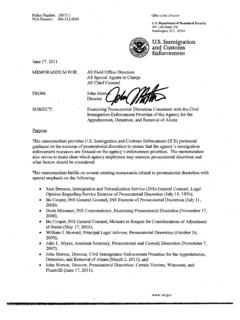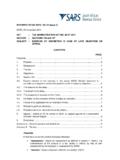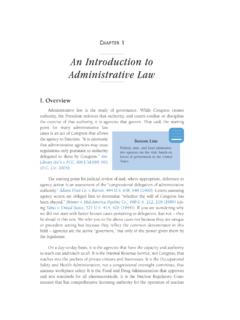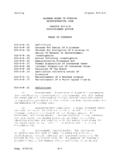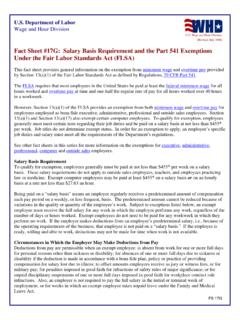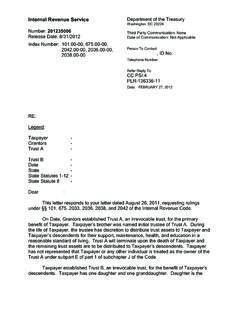Transcription of Guide to Segregation in Federal Prisons
1 Guide to Segregation in Federal Prisons See Program Statement on Inmate Discipline and Special Housing Units Segregation is the housing of inmates in special units separate from the general population. There are two types of Segregation outlined by the Bureau of Prisons : disciplinary and administrative detention. The rules and policies pertaining to each vary. Disciplinary Segregation (section ) Disciplinary Segregation is a form of separation from the general population for a specified period of time.
2 The Discipline Hearing Officer (DHO) orders disciplinary Segregation for inmates who have committed serious violations of BOP rules. The DHO can impose the sanction of disciplinary Segregation if she or he determines that no other available course of action will adequately punish that inmate to deter her or him from violating BOP rules again. Justification for placement in disciplinary Segregation 1) An inmate may be placed in disciplinary Segregation only by the order of the Discipline Hearing Officer (DHO) following a hearing in which it was found that the inmate violated a BOP rule in the Greatest, High, or Moderate categories, or a repeated offense in the Low Moderate Category.
3 (See section for more information on category definitions.) 2) The Warden may, for up to five days, move an inmate to a cell in disciplinary Segregation if that prisoner is causing a serious disruption in administrative detention, cannot be controlled within the physical confines of administrative detention, or has been medically referred to Segregation . Review of inmates in disciplinary Segregation The Segregation Review Official (SRO) must conduct a hearing and formally review the status of any inmate who spends seven continuous days in disciplinary Segregation .
4 The SRO is required to review these cases on a weekly basis and conduct a haring with a formal review once every 30 days. An inmate has the right to appear before the SRO at these 30 day hearings. The SRO may release an inmate from disciplinary Segregation early if she or he finds that keeping an inmate in Segregation is either no longer necessary or has fulfilled its purpose. The SRO may not increase any previously imposed sanction. Conditions of disciplinary Segregation Inmates housed in disciplinary Segregation have significantly fewer privileges than those in administrative Segregation .
5 The warden is required to ensure basic living levels of decency and humane treatment. These are: 1) Conditions of cell: The quarters used for Segregation must be well ventilated, adequately lighted, appropriately heated, and maintained in a sanitary condition at all times. All cells must be equipped with beds. Strip cells may not be part of the Segregation unit. 2) Cell: The number of inmates confined to each cell in Segregation should not exceed the number for which the space was designated.
6 The warden can approve increased occupancy if there is a pressing need. 3) Clothing and bedding: Inmates may wear normal institution clothing, but may not have a belt. Staff must furnish a mattress and bedding. Cloth or paper slippers may be substituted for shoes at the discretion of the warden. An inmate may not be segregated without clothing, mattress, blanks and pillow, except when prescribed by the medical officer for medical or psychiatric reasons. 4) Food: Inmates have a right to nutritionally adequate meals, usually from the menu of the day for the institution.
7 5) Personal hygiene: Inmates have a right to maintain an acceptable level of person hygiene. Staff must provide a toilet issue, a wash basin, a tooth brush, eyeglasses, shaving utensils, etc. as needed. Inmates should have the opportunity to shower and shave at least three times a week. 6) Exercise: Inmates have a right to no less than five hours of exercise a week. Exercise should be provided in five one-hour periods, on five different days. If circumstances require, 30 minute periods are acceptable if the five-hour minimum and different days scheduled is maintained.
8 Weight training is not available to segregated individuals. The warden may withhold exercise periods from a segregated individual for up to a week if the inmate is deemed a threat. 7) Personal Property: Personal property will normally be impounded. 8) Reading material: Inmates should have access to a reasonable amount of non-legal reading material. Religious scriptures of an inmate s faith need to be provided. 9) Supervision: Segregated inmates are to be seen daily by a member of the medical department and a responsible officer designated by the warden, in addition to the direct supervision of the unit officer.
9 10) Correspondence and visits: Staff should make reasonable efforts to notify approved social visitors of any restrictions on ordinary visiting procedures. Time Constraints of Disciplinary Segregations (section ) Offense Frequency of Offense Segregation Good Time Forfeiture 1st offense - Up to 7 days 2nd offense Up to 7 days Up to 15 days Low Moderate 3rd offense or more within 6 months Any sanctions in Moderate or Low Moderate series 1st offense Up to 15 days Up to 30 days 2nd offense within 12 months Up to 21 days Up to 30 days Moderate 3rd offense within 12 months Any sanctions in Moderate or High series 1st offense Up to 30 days Up to 60 days 2nd offense within 18 months Up to 45 days Up to 90 days
10 High 3rd offense within 18 months Any sanction in High or Greatest series Greatest 1st offense Up to 60 days Up to 100% Additionally, the DHO may also restrict the inmates privileges, take away the inmate s job, order the inmate to make monetary restitution, transfer the inmate, or recommend that the inmate s parole date be pushed back. Administrative Detention (section ) Administrative detention is a form of separation from the general population used when the continued presence of the inmate within the general population would pose a serious threat to the institution s security.
